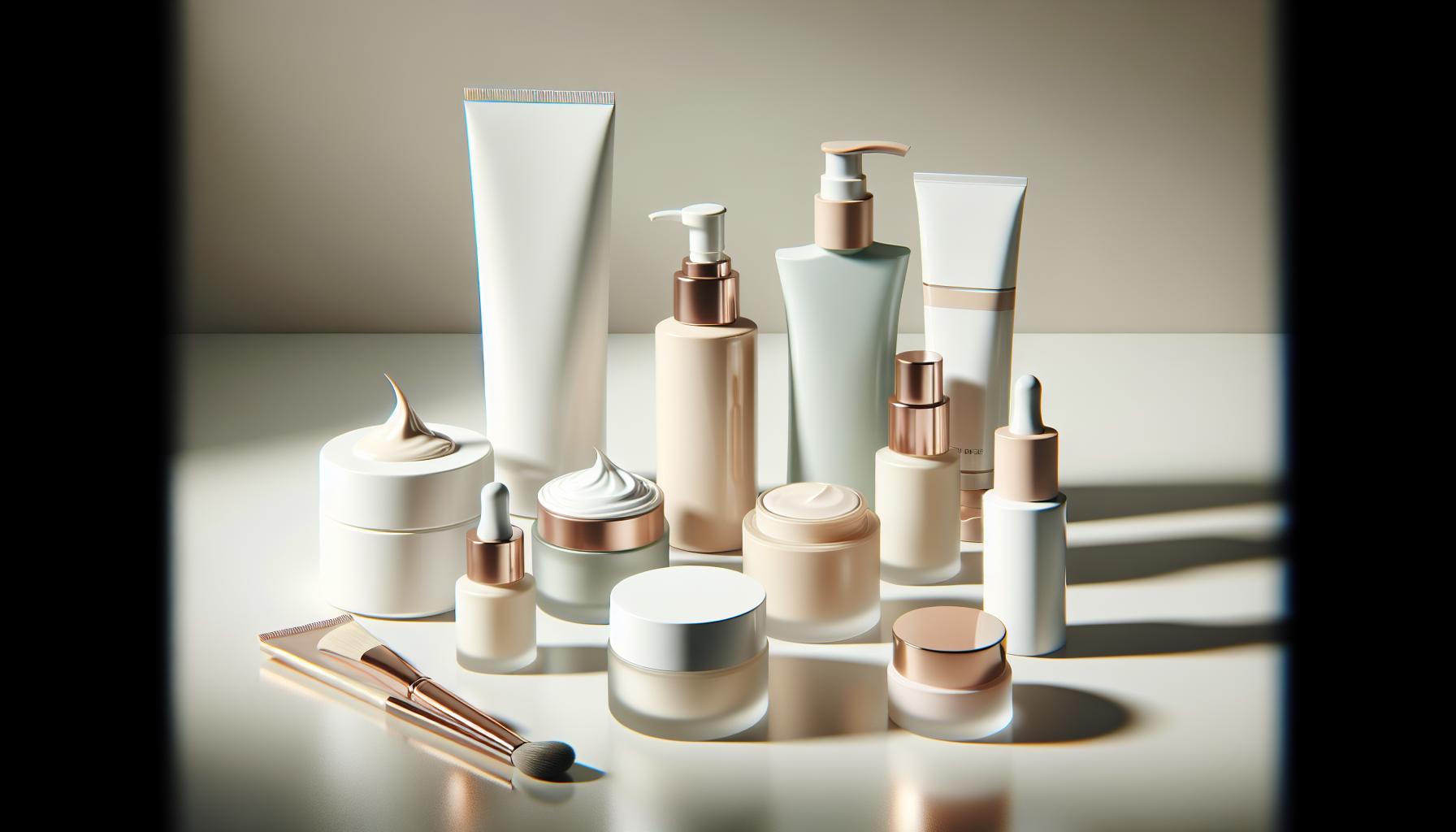Choosing the Right Shade and Formula
Selecting the perfect shade and formula of liquid foundation is key to creating that flawless base. Here, you’ll find what you need to consider to ensure you pick the best match for your skin.
Start by determining your skin undertone. Skin undertones fall into three categories: cool, warm, and neutral. A quick test to identify yours is the vein test. Look at the veins on your wrist; if they appear blue or purple, you’re likely cool-toned. If they look green, you’re warm-toned. Can’t decide? You might be neutral.
Once you’ve figured out your undertone, finding a shade that complements it becomes simpler. However, always test the foundation on your jawline to see how it blends with both your face and neck.
Choosing the right formula is just as crucial and often depends on your skin type. Here’s a quick guide:
| Skin Type | Recommended Formula |
|---|---|
| Oily | Matte-finish |
| Dry | Hydrating |
| Combination | Balancing |
| Sensitive | Hypoallergenic, fragrance-free |
Remember, the goal is to enhance, not mask your natural beauty. As makeup artist Bobbi Brown says, “Foundation should look like skin. Real skin.”
Don’t forget to consider the coverage you’re aiming for. Liquid foundations offer a range from sheer to full. Sheer coverage is great for a natural look, while full coverage will conceal blemishes and even out skin tone more extensively.
In addition to shade and formula, think about the foundation’s longevity and SPF protection. Especially if you’re going to wear it every day, these factors play a significant role in keeping your skin looking its best.
Prepping Your Skin

Before you dive into applying your liquid foundation, ensuring your skin is well-prepped is pivotal. Preparation is the key to making your foundation look flawless and last longer.
First, start with a clean slate by cleansing your skin thoroughly. Use a gentle cleanser suited for your skin type to remove any impurities or excess oils. This step ensures that your foundation will sit nicely on the skin without clinging to dry patches or sliding off oily areas.
After cleansing, hydration comes next. Applying a lightweight moisturizer can make a huge difference in how your foundation looks and feels. It gives the skin a plump, hydrated base, preventing the foundation from looking cakey. For oily skin types, opt for an oil-free moisturizer that hydrates without adding extra shine.
“A well-moisturized face is the perfect canvas for makeup.”
Next, don’t forget to prime your skin. A good primer can smooth out the skin’s texture, filling in any fine lines or pores, which helps in achieving an even application. Some primers also offer added benefits like controlling shine or hydrating dry areas.
| Skin Step | Purpose | Product Recommendation |
|---|---|---|
| Cleansing | Remove impurities and prepare skin | Gentle cleanser |
| Moisturizing | Hydrate and plump the skin | Lightweight moisturizer |
| Priming | Smooth texture and prolong foundation wear | Hydrating primer |
Lastly, if you’re aiming for long-lasting wear, consider lightly applying a setting spray on your face before the foundation. This can enhance the longevity of your makeup and keep it looking fresh throughout the day.
Applying Liquid Foundation
Now that your skin is prepped and primed, you’re ready to dive into the world of liquid foundation. The application process might seem straightforward, but a few techniques can elevate your makeup game.
First, it’s essential to choose the right tool for the application. Here’s a brief rundown:
| Tool | Finish |
|---|---|
| Sponge | Dewy |
| Brush | Full Coverage |
| Fingers | Natural |
For a dewy finish, dampen your sponge slightly before dipping it into the foundation. Dab it on your skin in bouncing motions until blended smoothly. The moisture in the sponge helps achieve that sought-after glow.
If you prefer full coverage, a brush is your go-to. Brushes work great for layering foundation and concealing blemishes or discoloration. Start from the center of your face and work outward, using downward strokes to mimic the direction of hair growth.
Using your fingers might seem old-school, but it’s perfect for a more natural look. The warmth of your hands helps the foundation blend seamlessly into your skin. Apply small dots around your face and gently blend using your fingertips.
Remember, the key to flawless foundation is less is always more. Start with a small amount; you can always build up coverage where needed. This approach prevents cakiness and maintains the skin-like finish that makes liquid foundation so beloved.
After application, assess your skin under different lights to ensure an even blend. Adjust as necessary, paying extra attention to the jawline and hairline, areas where foundation tends to accumulate or mismatch.
Techniques for Different Finishes
When you’re aiming for a specific look with your liquid foundation, the technique you choose is key. Whether you’re going for a matte, dewy, or satin finish, each requires a different approach. Here’s how you can achieve each one:
Matte Finish
For a matte look, you’ll want to start with a primer that controls oil. After applying your foundation, use a flat-top brush to buff the foundation into your skin. This ensures full coverage and a smooth look. To set everything in place, lightly dust translucent powder over your T-zone or any area where you tend to get oily.
Dewy Finish
If a dewy glow is what you’re after, the key is hydration. Start with a hydrating primer, then apply your liquid foundation with a damp beauty sponge. This helps add moisture and create that desired radiance. Avoid powder if possible, but if you must, gently pat a small amount under your eyes or on any blemishes.
Satin Finish
For a satin finish, which is somewhere in between matte and dewy, you’ll want to work in layers. Apply a light layer of foundation with a blending brush, then use a damp sponge to blend any excess product. This creates a natural, soft look that’s not too shiny but not flat either.
Pro Tip: Always assess your skin’s needs before applying makeup. Your skin type can dictate which finish will work best for you.
| Finish | Tool | Primer | Set With |
|---|---|---|---|
| Matte | Flat-top Brush | Oil Control | Translucent Powder |
| Dewy | Damp Beauty Sponge | Hydrating | Minimal Powder |
| Satin | Blending Brush | Light | Optional |
Remember, the perfect finish is about balancing what works best for your skin type and personal preference. Experiment with different techniques and products until you find your ideal match.
Final Touches
After mastering the basic application and achieving the right finish with your liquid foundation, the final touches can elevate your makeup look from good to flawless.
Set Your Foundation
To ensure your foundation stays in place all day, setting it with a powder is crucial. You’ve two main options: translucent for a more natural look and colored to add extra coverage. Use a fluffy brush for a light application. Here’s a quick guide to help you decide which setting powder to pick:
| Skin Type | Recommendation |
|---|---|
| Oily | Translucent |
| Dry | Hydrating formula, lightly applied |
| Combination | Target oily areas with translucent |
Add Depth and Dimension
Don’t forget the power of bronzer, blush, and highlighter. These not only add color back into your face but also contour and highlight your features, bringing life to the matte canvas of your foundation.
- Bronzer: Apply on the perimeter of your face and cheek hollows.
- Blush: Smile and apply on the apples of your cheeks.
- Highlighter: Apply on high points like cheekbones and brow bones.
Blending is Key
No matter how perfect your foundation looks, harsh lines from bronzers and blushes can ruin the effect. Use a clean brush to blend seamlessly, ensuring there are no distinct lines or patches.
Remember, makeup should enhance your features, not mask them. Each step you take, from applying foundation to the final touches, should aim to highlight your natural beauty. Make adjustments based on your face’s unique shape and what feels right for you.
Conclusion
After mastering the application of liquid foundation and setting it with powder for long-lasting wear, there’s more you can do to elevate your makeup game. Using bronzer, blush, and highlighter isn’t just about adding color; it’s about defining and enhancing your natural features. Each product plays a unique role in your makeup routine.
- Bronzer helps create a sun-kissed look and adds dimension.
- Blush gives your cheeks a healthy, youthful glow.
- Highlighter illuminates the face, highlighting areas where the light naturally hits.
When applying these products, remember that less is often more. It’s easy to go overboard, but strategic application can bring out your best features without looking overdone.
Here’s a quick guide to help you understand where to apply each product:
Bronzer: Along the perimeter of your face and beneath your cheekbones.
Blush: On the apples of your cheeks, blending towards your temples.
Highlighter: Above your cheekbones, on the brow bones, and the bridge of your nose.
Pro Tip: Always blend, blend, blend! The key to a seamless makeup look is making sure there are no harsh lines or obvious makeup marks.
For those curious about which products might best suit their needs, it’s important to consider your skin type and tone. Here’s a brief overview:
| Product | Dry Skin | Oily Skin | Sensitive Skin |
|---|---|---|---|
| Bronzer | Cream | Powder | Mineral |
| Blush | Cream | Powder | Mineral |
| Highlighter | Liquid | Powder | Liquid |
Remember, the goal of makeup is to enhance your natural beauty and feel confident in your own skin. Whether you’re aiming for a subtle day look or dramatic evening makeup, these final touches can make all the difference.




